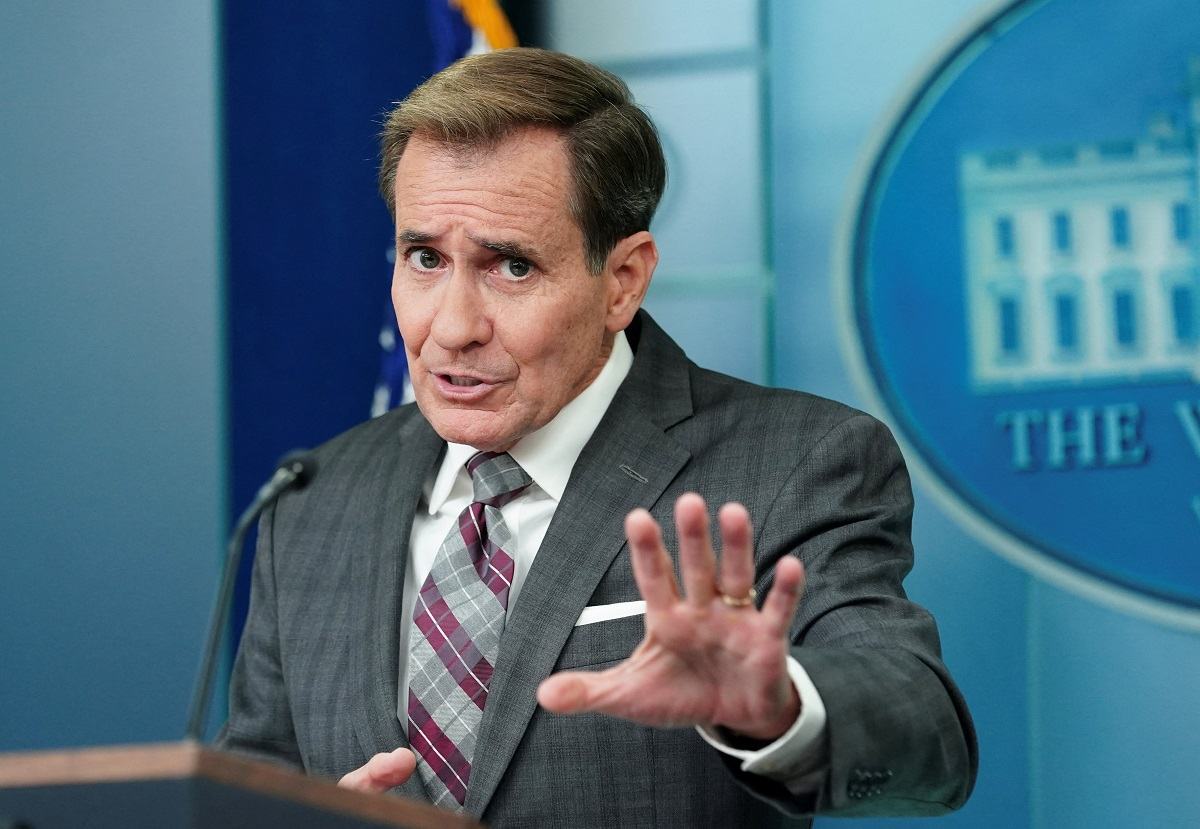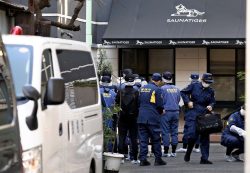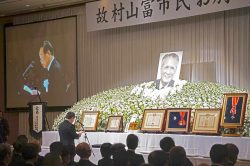North Korean Troops Are in Russia, Would be ‘Legitimate Targets’ in Ukraine, U.S. Says

White House national security spokesperson John Kirby answers a question during a press briefing at the White House in Washington, U.S., October 23, 2024.
13:02 JST, October 24, 2024
The U.S. government has evidence that at least 3,000 North Korean soldiers are in Russia receiving training, senior Biden administration officials said Wednesday, a development they said could have global implications and make those troops “legitimate military targets” in Ukraine should they enter the ongoing war there.
The disclosure, which officials said is based on newly declassified U.S. intelligence, coincides with similar pronouncements in recent days from the governments of Ukraine and South Korea. NATO and the United States had not previously confirmed the North Korean troop movements, and the administration said Washington was doing so now to convey the seriousness with which it views the matter.
“We recognize the potential danger here,” John Kirby, a spokesman for the National Security Council, told reporters at the White House. “And we’re going to be talking to allies and partners, including Ukrainians, about what the proper next steps are going to be.”
He emphasized repeatedly that the U.S. government does not yet know for certain that any North Korean soldiers will join the fighting in Ukraine, but he warned there would be consequences if they do.
“If these North Korean troops are employed against Ukraine,” Kirby said, “they will become legitimate military targets.”
For the United States and its partners, the assessment raises troubling questions about the extent to which Russia and North Korea – nuclear-armed nations and long-standing U.S. adversaries – might collaborate there and elsewhere. Speaking to reporters earlier Wednesday in Rome, Defense Secretary Lloyd Austin suggested the implications could be far-reaching.
“If they’re co-belligerents – if their intention is to participate in this war on Russia’s behalf – that is a very, very serious issue,” Austin said. “It will have impacts, not only in Europe. It will also impact things in the Indo-Pacific as well.”
Austin said it was not yet clear how North Korea might benefit from this deployment of its personnel but that it suggested significant weaknesses in Russia’s military capability more than two years into President Vladimir Putin’s full-scale invasion of Ukraine. The Russian leader has previously sought drones, missiles and other munitions from allies Iran and North Korea to help offset critical shortages.
“This is an indication that he may be even in more trouble than most people realize,” Austin said of Putin.
The conflict has left hundreds of thousands dead and wounded on both sides.
South Korea’s National Intelligence Service said last week that at least 1,500 North Korean special operations troops were training in Russia. They had been given Russian uniforms, weapons and IDs, and were being assigned to units composed of Siberian soldiers in a bid to conceal their nationalities, the intelligence agency reported. In a briefing to South Korean lawmakers Wednesday, the spy agency estimated that an additional 1,500 troops had moved into Russia.
Ukraine has said some North Korean advisers already are on the front lines.
At the White House, Kirby told reporters that Washington assesses that “at least 3,000” have traveled by ship to Vladivostok, a major Russian port city on the Pacific Ocean. U.S. officials did not release any satellite imagery verifying the claim, but Kirby said the North Koreans dispersed “to multiple Russian military training sites” in the country’s east. The North Koreans appear to be receiving a “basic kind of combat training and familiarization” at three sites, in what he called a “first tranche” of soldiers.
The Biden administration will continue to provide weapons and materiel support to Ukraine if North Korean forces enter the fighting there, Kirby said. He left open the possibility of other forms of escalation as well, though he did not identify what that could entail. President Joe Biden has said since the war’s start that he would not send any American troops to fight in Ukraine despite Washington’s robust military support for the government in Kyiv.
“I’m not at liberty today to go through any specific options,” Kirby said, “but we’re going to have those conversations. And we have.”
On Monday, the deputy U.S. ambassador to the United Nations, Robert Wood, said that if true, the dispatch of North Korean troops was “a dangerous and highly concerning development.” A day later, the NATO secretary general, Mark Rutte, said it would be “a significant escalation” – if that was the case.
Moscow and Pyongyang have repeatedly denied that there has been a deployment. A Russian Foreign Ministry spokeswoman on Wednesday called it a “colossal work of the media propaganda.”
From the beginning of Russia’s February 2022 invasion, North Korea has expressed strong support for Putin’s war in Ukraine, and the two countries signed a mutual defense pact over the summer, promising to expand military cooperation. South Korean officials have reported previously that Pyongyang has provided some 13,000 containers of weapons to Russia in as many as 70 shipments since August 2023, including missiles, antitank rockets, and up to 8 million desperately needed 122mm and 152mm artillery shells.
On Monday, South Korea insisted that Russia take “immediate” action to withdraw the North Korean troops. A day later, the government in Seoul warned that it could consider supplying weapons to Ukraine in response – a move that appeared aimed at pressuring Russia, given the domestic difficulties South Korea would face if it were to send weapons to Kyiv.
Seoul is weighing diplomatic, economic and military options and could consider sending both defensive and offensive weapons to Ukraine, said a senior South Korean official, speaking during a briefing with reporters on the condition of anonymity to discuss security matters.
Since the 1950-1953 Korean War halted in a cease-fire, the two Koreas have maintained robust artillery and weapons stockpiles in case conflict resumes. As the war in Ukraine drags on, those stockpiles on the Korean Peninsula have come under focus. Russia has apparently been turning to North Korea for its old Soviet-era shells and weapons.
South Korea has a robust defense industry and has been backfilling the U.S. artillery supply and delivering arms, in particular K2 battle tanks and K9 self-propelled howitzers, to Poland since 2022, allowing Warsaw to send its own equipment to Ukraine.
South Korean law bans the export of arms except for a peaceful purpose and has stopped short of supplying weapons directly to Ukraine. But officials are raising alarms about the potential for Russia to provide coveted weapons technology to North Korea in return for sending troops, saying it could intensify the North’s threats against the South.
"News Services" POPULAR ARTICLE
-

American Playwright Jeremy O. Harris Arrested in Japan on Alleged Drug Smuggling
-

Japan’s Nikkei Stock Average as JGB Yields, Yen Rise on Rate-Hike Bets
-

Japan’s Nikkei Stock Average Licks Wounds after Selloff Sparked by BOJ Hike Bets (UPDATE 1)
-

Japan’s Nikkei Stock Average Buoyed by Stable Yen; SoftBank’s Slide Caps Gains (UPDATE 1)
-

Japanese Bond Yields Zoom, Stocks Slide as Rate Hike Looms
JN ACCESS RANKING
-

Keidanren Chairman Yoshinobu Tsutsui Visits Kashiwazaki-Kariwa Nuclear Power Plant; Inspects New Emergency Safety System
-

Imports of Rare Earths from China Facing Delays, May Be Caused by Deterioration of Japan-China Relations
-

Tokyo Economic Security Forum to Hold Inaugural Meeting Amid Tense Global Environment
-

University of Tokyo Professor Discusses Japanese Economic Security in Interview Ahead of Forum
-

Japan Pulls out of Vietnam Nuclear Project, Complicating Hanoi’s Power Plans






















